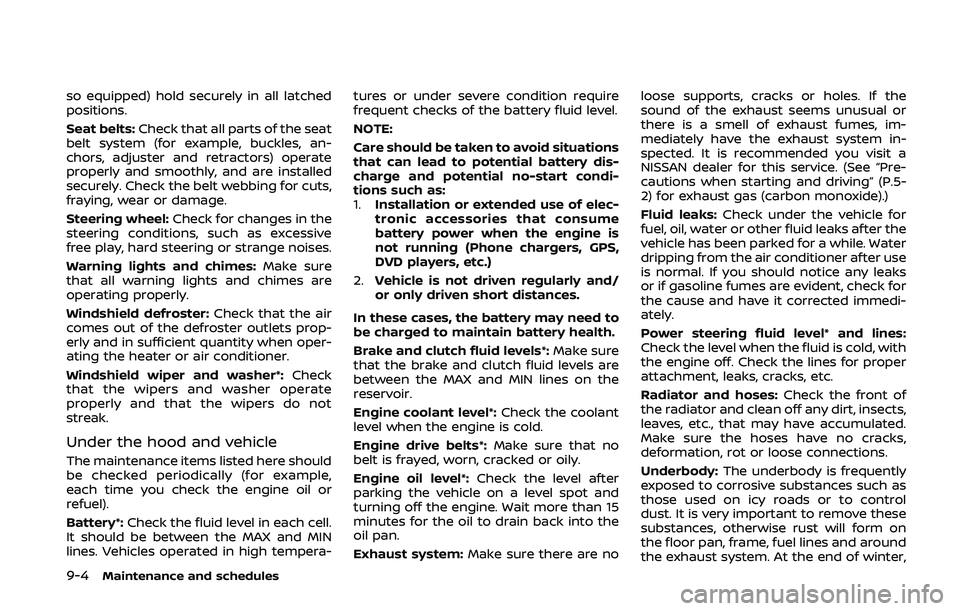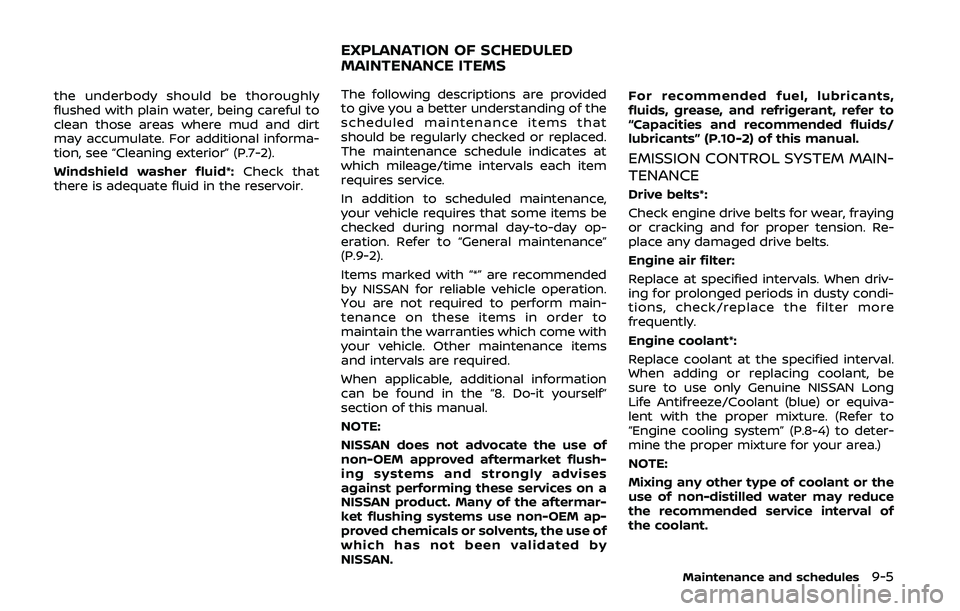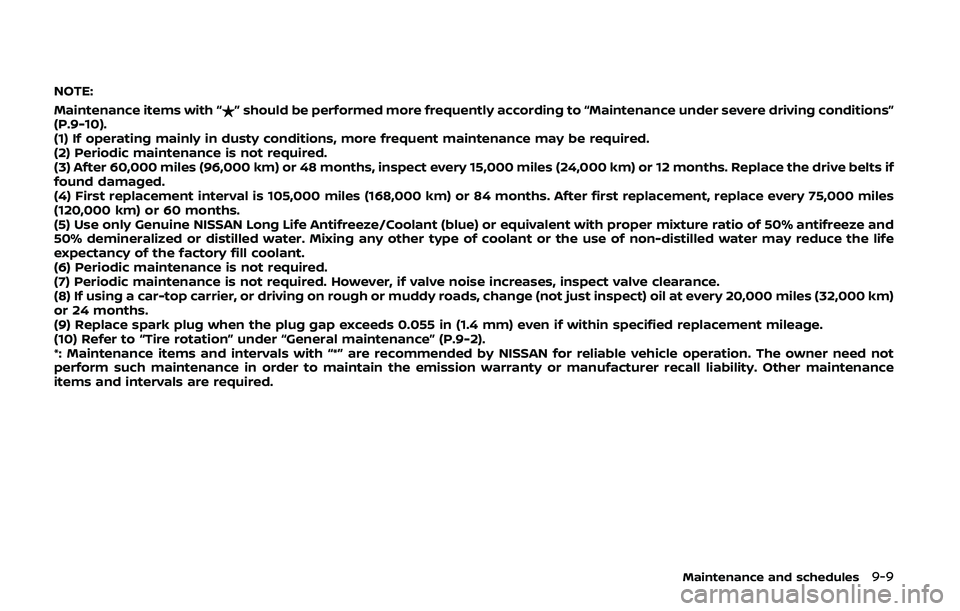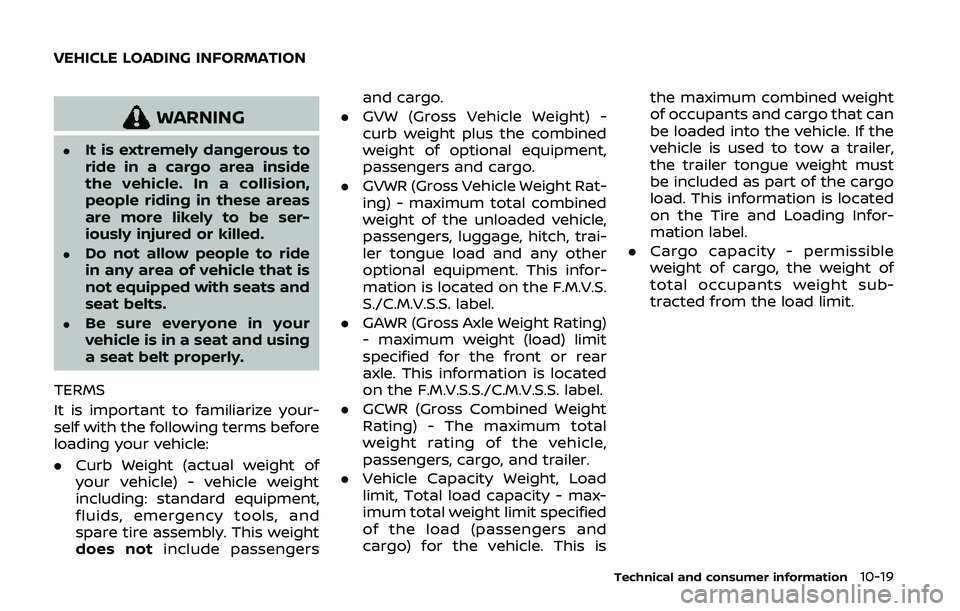2020 NISSAN 370Z belt
[x] Cancel search: beltPage 410 of 455

9-4Maintenance and schedules
so equipped) hold securely in all latched
positions.
Seat belts:Check that all parts of the seat
belt system (for example, buckles, an-
chors, adjuster and retractors) operate
properly and smoothly, and are installed
securely. Check the belt webbing for cuts,
fraying, wear or damage.
Steering wheel: Check for changes in the
steering conditions, such as excessive
free play, hard steering or strange noises.
Warning lights and chimes: Make sure
that all warning lights and chimes are
operating properly.
Windshield defroster: Check that the air
comes out of the defroster outlets prop-
erly and in sufficient quantity when oper-
ating the heater or air conditioner.
Windshield wiper and washer*: Check
that the wipers and washer operate
properly and that the wipers do not
streak.
Under the hood and vehicle
The maintenance items listed here should
be checked periodically (for example,
each time you check the engine oil or
refuel).
Battery*: Check the fluid level in each cell.
It should be between the MAX and MIN
lines. Vehicles operated in high tempera- tures or under severe condition require
frequent checks of the battery fluid level.
NOTE:
Care should be taken to avoid situations
that can lead to potential battery dis-
charge and potential no-start condi-
tions such as:
1.
Installation or extended use of elec-
tronic accessories that consume
battery power when the engine is
not running (Phone chargers, GPS,
DVD players, etc.)
2. Vehicle is not driven regularly and/
or only driven short distances.
In these cases, the battery may need to
be charged to maintain battery health.
Brake and clutch fluid levels*: Make sure
that the brake and clutch fluid levels are
between the MAX and MIN lines on the
reservoir.
Engine coolant level*: Check the coolant
level when the engine is cold.
Engine drive belts*: Make sure that no
belt is frayed, worn, cracked or oily.
Engine oil level*: Check the level after
parking the vehicle on a level spot and
turning off the engine. Wait more than 15
minutes for the oil to drain back into the
oil pan.
Exhaust system: Make sure there are no loose supports, cracks or holes. If the
sound of the exhaust seems unusual or
there is a smell of exhaust fumes, im-
mediately have the exhaust system in-
spected. It is recommended you visit a
NISSAN dealer for this service. (See “Pre-
cautions when starting and driving” (P.5-
2) for exhaust gas (carbon monoxide).)
Fluid leaks:
Check under the vehicle for
fuel, oil, water or other fluid leaks after the
vehicle has been parked for a while. Water
dripping from the air conditioner after use
is normal. If you should notice any leaks
or if gasoline fumes are evident, check for
the cause and have it corrected immedi-
ately.
Power steering fluid level* and lines:
Check the level when the fluid is cold, with
the engine off. Check the lines for proper
attachment, leaks, cracks, etc.
Radiator and hoses: Check the front of
the radiator and clean off any dirt, insects,
leaves, etc., that may have accumulated.
Make sure the hoses have no cracks,
deformation, rot or loose connections.
Underbody: The underbody is frequently
exposed to corrosive substances such as
those used on icy roads or to control
dust. It is very important to remove these
substances, otherwise rust will form on
the floor pan, frame, fuel lines and around
the exhaust system. At the end of winter,
Page 411 of 455

the underbody should be thoroughly
flushed with plain water, being careful to
clean those areas where mud and dirt
may accumulate. For additional informa-
tion, see “Cleaning exterior” (P.7-2).
Windshield washer fluid*:Check that
there is adequate fluid in the reservoir. The following descriptions are provided
to give you a better understanding of the
scheduled maintenance items that
should be regularly checked or replaced.
The maintenance schedule indicates at
which mileage/time intervals each item
requires service.
In addition to scheduled maintenance,
your vehicle requires that some items be
checked during normal day-to-day op-
eration. Refer to “General maintenance”
(P.9-2).
Items marked with “*” are recommended
by NISSAN for reliable vehicle operation.
You are not required to perform main-
tenance on these items in order to
maintain the warranties which come with
your vehicle. Other maintenance items
and intervals are required.
When applicable, additional information
can be found in the “8. Do-it yourself”
section of this manual.
NOTE:
NISSAN does not advocate the use of
non-OEM approved aftermarket flush-
ing systems and strongly advises
against performing these services on a
NISSAN product. Many of the aftermar-
ket flushing systems use non-OEM ap-
proved chemicals or solvents, the use of
which has not been validated by
NISSAN.For recommended fuel, lubricants,
fluids, grease, and refrigerant, refer to
“Capacities and recommended fluids/
lubricants” (P.10-2) of this manual.
EMISSION CONTROL SYSTEM MAIN-
TENANCE
Drive belts*:
Check engine drive belts for wear, fraying
or cracking and for proper tension. Re-
place any damaged drive belts.
Engine air filter:
Replace at specified intervals. When driv-
ing for prolonged periods in dusty condi-
tions, check/replace the filter more
frequently.
Engine coolant*:
Replace coolant at the specified interval.
When adding or replacing coolant, be
sure to use only Genuine NISSAN Long
Life Antifreeze/Coolant (blue) or equiva-
lent with the proper mixture. (Refer to
“Engine cooling system” (P.8-4) to deter-
mine the proper mixture for your area.)
NOTE:
Mixing any other type of coolant or the
use of non-distilled water may reduce
the recommended service interval of
the coolant.
Maintenance and schedules9-5
EXPLANATION OF SCHEDULED
MAINTENANCE ITEMS
Page 414 of 455

9-8Maintenance and schedules
STANDARD MAINTENANCE
Abbreviations: I = Inspect and correct or replace as necessary, R = Replace
MAINTENANCE OPERATION
Perform at number of miles, kilometers or months,
whichever comes first.Miles × 1,000
(km × 1,000) Months MAINTENANCE INTERVAL
7.5
(12) 6 15
(24) 12 22.5
(36) 18 30
(48) 24 37.5
(60) 30 45
(72) 36 52.5
(84) 42 60
(96) 48 67.5
(108) 54 75
(120) 60 82.5
(132) 66 90
(144) 72 97.5
(156) 78 105
(168) 84 112.5
(180) 90 120
(192) 96
Air cleaner filter NOTE (1)RR R R
Automatic transmission fluid NOTE (2)
Brake fluid$ RR RR
Brake lines and cables II II I I I I
Brake pads and rotors$ II II I I I I
Drive belts NOTE (3) I*I* I* I*I*
Engine coolant NOTE (4)(5)
Engine oil and oil filter$ RRRRRRRRRR RR R RR R
EVAP vapor lines and Fuel lines I*I* I* I*
Exhaust system$ II II
Fuel filter NOTE (6)
Intelligent Key battery IRRRR
In-cabin microfilter RR RR R R R R
Intake & exhaust valve clearance NOTE (7)
Manual transmission gear oil & differential gear oil NOTE (8)II II I I II
Spark plugs NOTE (9)Replace every 105,000 miles (168,000 km)
Steering gear and linkage, axle and suspension parts$ II II
Tire rotation NOTE (10)
Page 415 of 455

NOTE:
Maintenance items with “$” should be performed more frequently according to “Maintenance under severe driving conditions”
(P.9-10).
(1) If operating mainly in dusty conditions, more frequent maintenance may be required.
(2) Periodic maintenance is not required.
(3) After 60,000 miles (96,000 km) or 48 months, inspect every 15,000 miles (24,000 km) or 12 months. Replace the drive belts if
found damaged.
(4) First replacement interval is 105,000 miles (168,000 km) or 84 months. After first replacement, replace every 75,000 miles
(120,000 km) or 60 months.
(5) Use only Genuine NISSAN Long Life Antifreeze/Coolant (blue) or equivalent with proper mixture ratio of 50% antifreeze and
50% demineralized or distilled water. Mixing any other type of coolant or the use of non-distilled water may reduce the life
expectancy of the factory fill coolant.
(6) Periodic maintenance is not required.
(7) Periodic maintenance is not required. However, if valve noise increases, inspect valve clearance.
(8) If using a car-top carrier, or driving on rough or muddy roads, change (not just inspect) oil at every 20,000 miles (32,000 km)
or 24 months.
(9) Replace spark plug when the plug gap exceeds 0.055 in (1.4 mm) even if within specified replacement mileage.
(10) Refer to “Tire rotation” under “General maintenance” (P.9-2).
*: Maintenance items and intervals with “*” are recommended by NISSAN for reliable vehicle operation. The owner need not
perform such maintenance in order to maintain the emission warranty or manufacturer recall liability. Other maintenance
items and intervals are required.
Maintenance and schedules9-9
Page 439 of 455

WARNING
.It is extremely dangerous to
ride in a cargo area inside
the vehicle. In a collision,
people riding in these areas
are more likely to be ser-
iously injured or killed.
.Do not allow people to ride
in any area of vehicle that is
not equipped with seats and
seat belts.
.Be sure everyone in your
vehicle is in a seat and using
a seat belt properly.
TERMS
It is important to familiarize your-
self with the following terms before
loading your vehicle:
. Curb Weight (actual weight of
your vehicle) - vehicle weight
including: standard equipment,
fluids, emergency tools, and
spare tire assembly. This weight
does not include passengers and cargo.
. GVW (Gross Vehicle Weight) -
curb weight plus the combined
weight of optional equipment,
passengers and cargo.
. GVWR (Gross Vehicle Weight Rat-
ing) - maximum total combined
weight of the unloaded vehicle,
passengers, luggage, hitch, trai-
ler tongue load and any other
optional equipment. This infor-
mation is located on the F.M.V.S.
S./C.M.V.S.S. label.
. GAWR (Gross Axle Weight Rating)
- maximum weight (load) limit
specified for the front or rear
axle. This information is located
on the F.M.V.S.S./C.M.V.S.S. label.
. GCWR (Gross Combined Weight
Rating) - The maximum total
weight rating of the vehicle,
passengers, cargo, and trailer.
. Vehicle Capacity Weight, Load
limit, Total load capacity - max-
imum total weight limit specified
of the load (passengers and
cargo) for the vehicle. This is the maximum combined weight
of occupants and cargo that can
be loaded into the vehicle. If the
vehicle is used to tow a trailer,
the trailer tongue weight must
be included as part of the cargo
load. This information is located
on the Tire and Loading Infor-
mation label.
. Cargo capacity - permissible
weight of cargo, the weight of
total occupants weight sub-
tracted from the load limit.
Technical and consumer information10-19
VEHICLE LOADING INFORMATION
Page 445 of 455

https://wwwapps.tc.gc.ca/Saf-Sec-
Sur/7/PCDB-BDPP/fc-cp.aspx?
lang=fra (French speakers).
Additional information concerning
motor vehicle safety may be ob-
tained from Transport Canada’s
Road Safety Information Centre at
1-800-333-0371 or online at www.
tc.gc.ca/roadsafety (English speak-
ers) or www.tc.gc.ca/securiterou-
tiere (French speakers).
To notify NISSAN of any safety
concerns please contact our Con-
sumer Information Centre toll free
at 1-800-387-0122.Due to legal requirements in some states
and Canadian Provinces, your vehicle may
be required to be in what is called the
“ready condition” for an Inspection/Main-
tenance (I/M) test of the emission control
system.
The vehicle is set to the “ready condition”
when it is driven through certain driving
patterns. Usually, the “ready condition”
can be obtained by ordinary usage of
the vehicle.
If a powertrain system component is
repaired or the battery is disconnected,
the vehicle may be reset to a “not ready
condition”. Before taking the I/M test,
check the vehicle’s inspection/mainte-
nance test readiness condition. Place the
ignition switch in the ON position without
starting the engine. If the Malfunction
Indicator Light (MIL) comes on steady for
20 seconds and then blinks for 10 sec-
onds, the I/M test condition is “not ready”.
If the MIL does not blink after 20 seconds,
the I/M test condition is “ready”.
It is recommended you visit a NISSAN
dealer to set the “ready condition” or to
prepare the vehicle for testing.This vehicle is equipped with an Event
Data Recorder (EDR). The main purpose of
an EDR is to record, in certain crash or
near crash-like situations, such as an air
bag deployment or hitting a road obsta-
cle, data that will assist in understanding
how a vehicle’s systems performed. The
EDR is designed to record data related to
vehicle dynamics and safety systems for a
short period of time, typically 30 seconds
or less. The EDR in this vehicle is designed
to record such data as:
.
How various systems in your vehicle
were operating;
. Whether or not the driver and passen-
ger safety belts were buckled/fas-
tened;
. How far (if at all) the driver was
depressing the accelerator and/or
brake pedal; and,
. How fast the vehicle was traveling.
. Sounds are not recorded.
These data can help provide a better
understanding of the circumstances in
which crashes and injuries occur. NOTE:
EDR data are recorded by your vehicle
only if a nontrivial crash situation occurs;
no data are recorded by the EDR under
normal driving conditions and no perso-
nal data (e.g. name, gender, age and crash
location) are recorded. However, other
parties, such as law enforcement, could
Technical and consumer information10-25
READINESS FOR INSPECTION/
MAINTENANCE (I/M) TEST EVENT DATA RECORDERS (EDR)
Page 447 of 455

11 Index
A
ABS (Anti-lock Braking System) ....................... 5-28
Active noise cancellation....................................... 5-35
Active sound enhancement................................ 5-35
Advanced air bag system ..................................... 1-37
Air bag systemAdvanced air bag system .............................. 1-37
Front passenger air bag and
status light................................................................. 1-39
Front-seat mounted side-impact
supplemental air bag system..................... 1-42
Roof-mounted curtain side-impact
supplemental air bag system..................... 1-42
Air bag warning labels ............................................ 1-45
Air bag warning light................................. 1-45, 2-15
Air cleaner housing filter ....................................... 8-15
Air conditioner Air conditioner operation............................... 4-31
Air conditioner service...................................... 4-36
Air conditioner specification label....... 10-14
Air conditioning system refrigerant and
lubricant recommendations ......... 4-36, 10-8
In-cabin microfilter .............................................. 4-36
Air deflectors ................................................................ 10-18
Alarm, How to stop alarm (see vehicle
security system)............................................................ 2-32
Alcohol, drugs and driving ....................................... 5-7
Antenna........................................................................\
....... 4-80
Anti-lock Braking System (ABS) ....................... 5-28
Anti-lock braking system (ABS)
warning light ................................................................... 2-11
Appearance care Exterior appearance care ................................. 7-2
Interior appearance care................................... 7-5
Audible reminders....................................................... 2-18 Audio operation precautions ............................. 4-37
Audio system .................................................................. 4-37
FM-AM radio with Compact Disc
(CD) player .................................................................. 4-49
FM-AM-SAT radio with Compact Disc
(CD) player .................................................................. 4-58
Steering wheel audio controls................... 4-79
Autolight system.......................................................... 2-36
Automatic Air conditioner (Type A)................................... 4-32
Air conditioner (Type B)................................... 4-34
Automatic adjusting function
(front windows) ...................................................... 2-50
Automatic Transmission Fluid (ATF) ........ 8-8
Door locks...................................................................... 3-5
Driving with
automatic transmission .................................. 5-12
Auxiliary input jacks................................................... 4-76
Average fuel consumption and speed ....... 2-26
Avoiding collision and rollover.............................. 5-6
B
Battery........................................................................\
.......... 8-11 Battery saver system......................................... 2-37
Intelligent Key.......................................................... 8-20
Variable voltage control system .............. 8-13
Before starting the engine................................... 5-11
Belts (See drive belts)............................................... 8-14
Bluetooth® hands-free phone system
(models with navigation system) ................... 4-82
Bluetooth® hands-free phone system
(models without navigation system) ........... 4-92
Bluetooth® streaming audio............................... 4-69
Booster seats.................................................................. 1-27 Brake
Anti-lock Braking System (ABS) ................ 5-28
Brake and clutch fluid ......................................... 8-9
Brake fluid ..................................................................... 8-9
Brake system ........................................................... 5-27
Parking brake operation................................. 5-21
Warning light............................................................ 2-11
Break-in schedule ....................................................... 5-24
Brightness control .......................................................... 4-8 Display ON/OFF button ...................................... 4-8
Instrument panel .................................................. 2-38
Bulb replacement ........................................................ 8-22
C
Cabin air filter ................................................................. 4-36
Capacities and
recommended fluids/lubricants...................... 10-2
Car phone or CB radio ............................................ 4-81
Cargo cover ..................................................................... 2-47
Catalytic converter, Three way catalyst ....... 5-3
CD/DVD/USB memory care
and cleaning.................................................................... 4-78
Center multi-function control panel
(models with navigation system) ....................... 4-4
Child restraints .............................................................. 1-20 Booster seats........................................................... 1-27
Precautions on child restraints................. 1-20
Top tether strap .................................................... 1-21
Child safety....................................................................... 1-17
Chimes Audible reminders................................................ 2-18
Seat belt warning light
and chime.................................................... 1-12, 2-14
Circuit breaker, Fusible link ................................. 8-18
Cleaning exterior and interior ................... 7-2, 7-5
Page 448 of 455

11-2
Clock ........................................................................\
... 2-9, 2-28
Clutch fluid........................................................................\
.... 8-9
Cockpit ........................................................................\
............. 2-3
Cold weather driving ................................................ 5-33
Compact Disc (CD) player (See
audio system) ................................................................. 4-60
Compact spare tire.................................................... 8-37
Console box ..................................................................... 2-46
CoolantCapacities and
recommended fluids/lubricants............... 10-2
Changing engine coolant ................................. 8-5
Checking engine coolant level...................... 8-5
Corrosion protection .................................................... 7-8
Cover, Cargo cover..................................................... 2-47
Cruise control ................................................................. 5-22
Cup holders...................................................................... 2-44
D
Dampers, Performance dampers.................... 5-32
Daytime running light system........................... 2-38
Defroster switch, Rear window
defroster switch ........................................................... 2-34
Dimensions .................................................................... 10-11
Drive belts...................................................................\
....... 8-14
Driving Cold weather driving ......................................... 5-33
Driving with
automatic transmission .................................. 5-12
Driving with manual transmission.......... 5-17
Precautions when starting
and driving.................................................................... 5-2
DVD player operation............................................... 4-61
E
Economy, Fuel................................................................ 5-25
Elapsed time.................................................................... 2-26
Emergency tire puncture repair kit .................. 6-9
Emission control information label............ 10-13
Emission control system warranty ............ 10-24
Engine Before starting the engine............................ 5-11
Break-in schedule ................................................ 5-24
Capacities and
recommended fluids/lubricants............... 10-2
Changing engine coolant ................................. 8-5
Changing engine oil and filter ...................... 8-6
Checking engine coolant level...................... 8-5
Checking engine oil level................................... 8-6
Coolant temperature gauge .......................... 2-7
Emergency engine shut off.......................... 5-10
Engine block heater ........................................... 5-34
Engine compartment
check locations ......................................................... 8-3
Engine cooling system ........................................ 8-4
Engine oil.....................................................................\
... 8-6
Engine oil and oil
filter recommendation ..................................... 10-7
Engine oil replacement indicator ............ 2-24
Engine oil temperature gauge...................... 2-8
Engine oil viscosity .............................................. 10-7
Engine serial number .................................... 10-13
Engine specifications......................................... 10-9
Engine start operation indicator.............. 2-20
Engine start operation indicator
(Manual Transmission models).................. 2-21
If your vehicle overheats ................................ 6-17
Starting the engine............................................. 5-11
Event Data Recorders (EDR)............................. 10-25
Exhaust gas (carbon monoxide) ......................... 5-2 Explanation of scheduled
maintenance items ........................................................ 9-5
Extended storage fuse warning ...................... 2-23
Exterior light indicator............................................. 2-16
F
F.M.V.S.S./C.M.V.S.S. certification label ...... 10-13
Filter
Air cleaner housing filter ................................ 8-15
Changing engine oil and filter ...................... 8-6
Flashers (See hazard warning
flasher switch).................................................................... 6-2
Flat tire........................................................................\
............. 6-3 Repairing flat tire (with emergency tire
puncture repair kit) ................................................ 6-9
Flat towing..................................................................... 10-22
Floor mat cleaning ......................................................... 7-6
Floor mat installation................................................... 7-7
Fluid Automatic Transmission Fluid (ATF) ........ 8-8
Brake and clutch fluid ......................................... 8-9
Brake fluid ..................................................................... 8-9
Capacities and
recommended fluids/lubricants............... 10-2
Engine coolant........................................................... 8-4
Engine oil.....................................................................\
... 8-6
Power steering fluid .............................................. 8-8
Window washer fluid ......................................... 8-10
FM-AM radio with Compact Disc
(CD) player ........................................................................\
. 4-49
FM-AM-SAT radio with Compact Disc
(CD) player ........................................................................\
. 4-58
Fog light switch ............................................................ 2-39
Front manual seat adjustment ............................ 1-4
Front passenger air bag and
status light........................................................................\
1-39